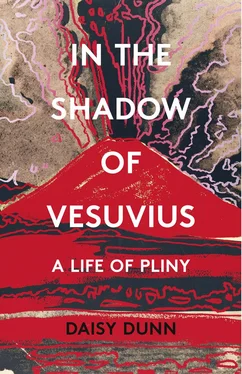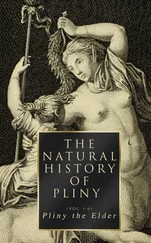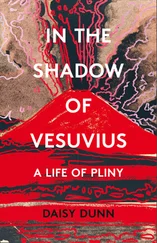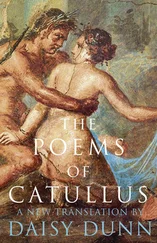His nephew was no less versatile. Though commonly confused with his namesake through Late Antiquity and the Middle Ages, Pliny the Younger was an important figure in his own time. 2He survived the Vesuvius disaster to become a lawyer, senator, poet, collector of villas, curator of drains, and personal representative of the emperor overseas. He was also a prolific writer of letters, a couple of which contain his account of the eruption. It took a priest at the cathedral of Verona in the early fourteenth century to disentangle the orator who wrote these letters from the historian and admiral of the fleet who produced the encyclopaedia and perished beneath the volcano . 3Giovanni de Matociis, the author of a book on empire from Rome to Charlemagne, produced a critical essay which, though laden with errors, made the essential point. There was not one Pliny but two.
In around 1500, a complete manuscript containing over three hundred of Pliny the Younger’s letters – far more than de Matociis had known of – was miraculously uncovered in an abbey in Paris. The papyrus dated to the fifth century, making it one of the oldest classical manuscripts ever found (six leaves of it still survive in a library in New York). Aldus Manutius, one of the great publishers of Renaissance Venice, acquired it to produce a book of Pliny the Younger’s correspondence, for which there was now a considerable appetite. 4The discovery in 1419 of an incomplete manuscript in Verona (or possibly Venice) had prompted the first printed edition of the younger Pliny’s letters in 1471, two years after his uncle’s encyclopaedia was first published in print. 5The release of books by two Plinys in as many years was met with considerable emotion across Italy.
No sooner had the books been published than an intense intellectual dispute broke out between the cities of Verona and Como (ancient Comum) over the birthplace of the uncle and nephew. The Veronese priest de Matociis had been in no doubt that the pair were native to his home town. In the preface to his encyclopaedia, Pliny the Elder invoked Catullus, the love poet born in Verona in the first century BC, as his ‘fellow countryman’. Verona and Comum both formed part of former Gaul. The Veronese now seized upon these words as proof that Pliny the Elder was one of them. Rattled by their presumption and haughtiness, the people of Como, a town some 150 kilometres to Verona’s north-west, retrieved their copies of the Natural History and threw open its covers to reveal what was written in the frontispiece. Early editions of the encyclopaedia were prefaced by a biographical note which identified Pliny the Elder explicitly as a man of ancient Como. 6The Veronese refused to back down. The horror of having witnessed scholar after scholar, poet after humanist – Petrarch, Flavio Biondo, Lorenzo Valla, Niccolò Perotti – come out in support of Verona’s rivalrous claim eventually drove the people of Como to more extreme measures. 7In their determination to win this contest they commissioned a sculptor to produce larger-than-life-size statues of both Plinys, which they displayed prominently in their town centre. The Veronese responded by erecting a statue of the elder Pliny on the rooftop of their council building. If they could not have both Plinys they could at least have one. Standing among the most famous sons of ancient Verona – Catullus and Cornelius Nepos, the dedicatee of his poetry book, the architectural writer Vitruvius, and the poet Aemilius Macer – Pliny the Elder would watch over Verona’s Piazza dei Signori for ever after. 8
If the people of Como were going to settle this dispute, they had no choice but to produce a definitive portrait of the lives of the Plinys in their ancient town. The task was taken up in the sixteenth century by a pair of polymaths: Paolo Giovio, a collector of art, advisor to the art historian Giorgio Vasari, and physician to Pope Clement VII, and his brother Benedetto, a notary, classical scholar, and historian. 9Gifted and imaginative, if not also highly impressionable, they were precisely what Como needed. Paolo put aside his copy of the Natural History , picked up the Letters and began to dream of constructing a novel kind of museum-villa in memory of Pliny the Younger. Meanwhile Paolo’s brother sought to deconstruct the Veronese claims to Pliny the Elder on textual grounds and to re-establish the connection of Pliny the Younger to the town through archaeology. It would take time and ingenuity but the Giovio brothers would prevail. The Plinys were men of ancient Como – and they were worth fighting over.
Pliny the Elder was born Gaius Plinius Secundus in Comum in AD 23 or 24. His family was of the second highest social order, the equestrians, which meant that he was wealthy, but not so illustrious in his birth as the Julii or Claudii or any of the other great patrician families who had filled the Roman senate for centuries. fn1He began his career, as was customary for a man of his class, with a spell of military service, which he took to with assiduity. In AD 47, thirty years prior to his appointment as admiral of the fleet, he joined a campaign off what is now the Netherlands and found himself waging ‘a naval battle against trees’. 10He was on the lakes when he saw them. They were not rolling over the surface of the water, but floating towards him as upright as ships’ masts. It was terrifying. He recalled that the trees often took the men when they were least prepared, ‘driven by the waves as if purposely against our prows when we were moored at night’. The men had no choice but to confront the huge trunks head on.
It was typical of Pliny the Elder to seek an explanation for the peculiarities of the landscapes he encountered on his tours: it was because the trees on the banks attained such heights in their ‘determination to grow’ that they could be borne along vertically on their roots when they were torn up by the wind and waves. The description sounds fanciful but it is perfectly possible for a current to carry trees along on their roots. Many stumps were carried erect down river during the eruption of Mount St Helens in Washington State in 1980. 11It is thought that the petrified forests of Yellowstone National Park may also have developed as a result of trees being carried upright through water. 12
The curiosity that drew Pliny the Elder towards Mount Vesuvius, and his death, was the product of a lifetime’s fascination with the natural world. Already as a young soldier he was making observations which he would incorporate into his Natural History. His description of trees floating across the lake was included in a section on the forests of Germania. It was a rare piece of reflection, for Pliny the Elder seldom paused to reminisce on his own experiences, and an important one, for it was in these woods, so thick that they ‘add to the cold with their shade’, that the Romans had suffered one of their most crushing defeats in recent history.
At the end of the previous century, the first Roman emperor, Augustus, had sent the Roman army into German territory in the hope of pushing their frontier north beyond the Rhine towards the River Elbe. 13Drusus, son of Augustus’ third wife Livia, enjoyed some formidable early successes in the campaign, but died in 9 BC following a fall from his horse. About fifty years later, Pliny the Elder dreamed that he had been visited by Drusus’ ghost. According to Pliny the Younger, it was as a result of this encounter, in which Drusus begged to be saved from ‘the injustice of being forgotten’, that his uncle went on to produce a twenty-volume account of the German Wars. 14The work is sadly now lost but proved useful to later historians, who referred to its passages on Agrippina the Elder, mother of the emperor Caligula, and her attainment of more power over the Roman army than the generals themselves. 15
Читать дальше












